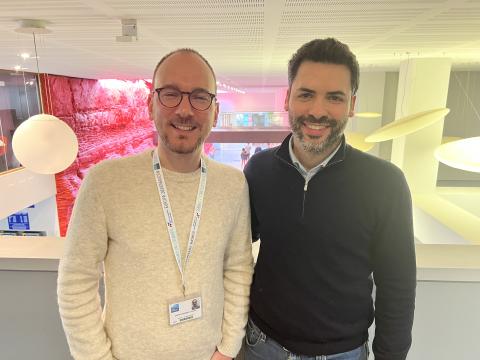Telemonitoring for patients who have undergone shoulder replacement

Uccle, 19/03/2025 – The Europe Hospitals are the first hospital in French-speaking Belgium to offer telemonitoring for patients who have undergone rotator cuff repair, as part of the call for innovation projects funded by the FPS Public Health. To do this, they have chosen the MoveUP application. We meet Dr Mathias Colman, shoulder surgeon, and Jonathan Cortes, nurse and telemonitoring coordinator.
This project is part of the project Digitalisation of orthopaedic care called ‘ENOrtho’, which brings together six participating hospitals (the Europe Hospitals, Chirec, the CHRSM, the Clinique Saint-Luc Bouge, the HELORA hospitals and the Clinique Saint-Pierre in Ottignies, which is the coordinating hospital). The common thread running through these various projects is that they aim to optimise the orthopaedic patient care pathway.
‘The primary idea behind this FPS Public Health project is to enable hospitals to make the best use of their valuable staff resources. As hospital stays are becoming shorter and shorter, patients are returning home with pain that is not yet properly managed. Telemonitoring makes it possible to continue supporting patients even at home,’ reports Jonathan Cortes, telemonitoring nurse coordinator.
‘As a result, the quality of care is improved and the patient's participation in his or her healing process is increased. It's a different approach to care where the patient is much more involved, where he or she has to do his or her share of the work,’ continues Jonathan Cortes.
MoveUP extended to the shoulder
To date, there is no consensus on how to rehabilitate a rotator cuff suture(1). ‘The idea here is to integrate rehabilitation for this procedure into the MoveUP application, which already exists for other orthopaedic procedures such as total hip replacement, total knee replacement, etc.’, reports Dr Colman, a shoulder surgeon, who has opted for this procedure because it is the one he performs the most and is the most standardised.
The primary objective of this application is to provide a point of contact for post-operative patients. ‘Patients can assess their pain in the application, which transmits any warning signals (abnormal pain, redness, etc.) to the telemonitoring coordinator,’ says the surgeon.
The second objective is to support them in their mobilisation: ‘Usually, patients start physiotherapy sessions after two weeks when the pain has subsided. And even once they have started physiotherapy, they only have sessions 2 to 3 times a week. The idea is to offer patients small mobilisation exercises for the hand, wrist and elbow just after the operation, before starting physiotherapy, and once the physiotherapy has started, on the days when they do not see the physiotherapist,’ explains Mathias Colman.
A special bond between patient and nurse
This application can be beneficial to all patients who have undergone rotator cuff surgery. ‘As soon as a patient is scheduled for this procedure, I call them to offer them the application, explaining its purpose and benefits. It's a fairly innovative approach, so patients are curious and want to find out more,’ explains the telemonitoring coordinator. ‘In addition to monitoring pain, wounds and painkiller intake, as well as mobilisation exercises, the application also has a messaging service that allows patients to contact me. I then analyse the situation and, if necessary, I call them back. This telephone contact is very reassuring for them’.
Barbara, who had her first operation in November, benefited from the MoveUP application after her second operation in January. She testifies to its added value: ‘I followed the programme as soon as I left the hospital and found it very motivating because it gave me confidence in myself. I see this app as moral support, but also practical support with the exercises on offer. Moreover, it was really very effective in monitoring the pain assessment when I fell. I wrote directly that I was in severe pain and the coordinating nurse immediately phoned me to see what should be done. I am really delighted with this experience, which was totally different from my recovery after my first operation, when I did not have the application. ’
This is a project that is funded for 18 months by the FPS Public Health. In addition to being able to offer closer support to patients, Dr Colman also hopes to be able to objectify the management of pain caused by this surgical procedure in a large number of patients, both during the day and at night, in order to be able to refine his post-operative painkiller prescriptions. A great project where everyone wins!
(1) Rotator cuff surgery involves repairing a rupture of the tendons in the shoulder to reduce pain and restore strength to the patient.

